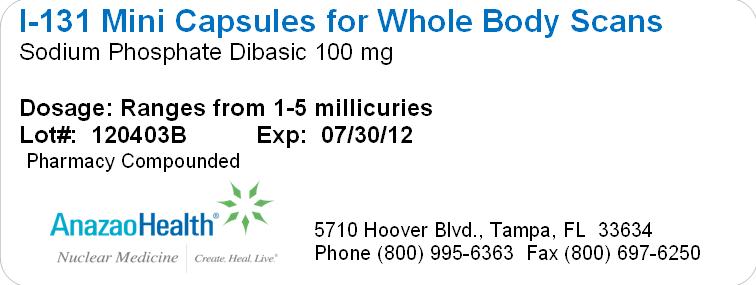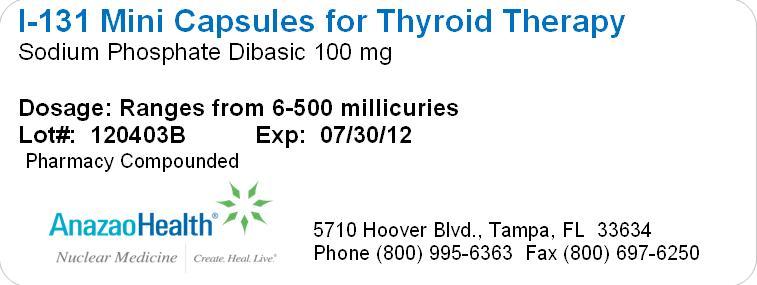Label: I 131 MINI capsule
-
Contains inactivated NDC Code(s)
NDC Code(s): 51808-119-01 - Packager: AnazaoHealth Corporation
- Category: HUMAN PRESCRIPTION DRUG LABEL
- DEA Schedule: None
- Marketing Status: unapproved drug other
DISCLAIMER: This drug has not been found by FDA to be safe and effective, and this labeling has not been approved by FDA. For further information about unapproved drugs, click here.
Drug Label Information
Updated May 23, 2012
If you are a consumer or patient please visit this version.
- Download DRUG LABEL INFO: PDF XML
- Official Label (Printer Friendly)
-
DESCRIPTION
Sodium Iodide I-131 (NaI-131) for therapeutic use is supplied for oral administration in small opaque white gelatin capsules, inside a blue and clear outer capsule. Each I-131 mini capsule is available in strengths ranging from (0.1 – 150 mCi) at the time of calibration. Iodine 131 decays by beta emission and associated gamma emission with a physical half-life of 8.04 days.
Sodium Iodide I-131 Mini Capsules are compounded by absorbing a solution of carrier-free sodium iodide I-131 into inert filler. The iodine 131 utilized in the preparation of the capsules contains not less than 99% Iodine-131 at the time of calibration.
Gelatin capsules are compounded per prescription requirements using high specific concentration I-131, allowing higher iodine activity in a small easy to swallow high activity capsule size. Capsules are formulated to rapidly dissolve in saline solution, to allow use for oral solution administration when clinically necessary.
-
CONTRAINDICATIONS AND ADVERSE REACTIONS
Radioiodine is excreted in human milk during lactation; breast feeding must be substituted during and following dose administration. Sodium Iodide 131 is not usually used for treatment of hyperthyroidism in patients under 30 years of age. Reactions to administration are rare; however potential side effects such as radiation sickness and bone marrow depression, acute leukemia, anemia, chromosomal abnormalities, acute thyroid crisis, blood dyscrasia, leukopenia, thrombocytopenia, and death represent potential side effects.
-
DOSAGE AND ADMINISTRATION
Anti-thyroid therapy of a severely hyperthyroid patient is usually discontinued three to four days before administration of radioiodide. For hyperthyroidism, the usual dose range is 4 to 10 mCi. Toxic nodular goiter and other special situations will require the use of larger doses. For thyroid carcinoma, 50 mCi is the usual dose for ablation of normal thyroid tissue, and 100 to 150 mCi is the usual subsequent therapeutic dose. Waterproof gloves should be used during the entire handling and administration procedure. Adequate shielding must be maintained.
-
CLINICAL UTILITY
Most patients with thyroid disease present with a thyroid nodule. Tools utilized to assess thyroid nodules and to rule out thyroid cancer include: serum thyroid function tests (TSH and thyroid hormone level), thyroid ultrasound (US), radionuclide scintigraphy (low activity I-131, I-123 and/or Tc99m), and fine needle aspiration (FNA) for cytology (cells) examination. High thyroid hormone levels (T4 or T3) and a low TSH level may indicate a nodule is a benign hyperfunctioning nodule (adenoma), thereby tending to rule out thyroid cancer. In such cases, thyroid imaging (US or scintigraphy) determines whether the nodule is hyperfunctioning whereas thyroid cancers appear under-functioning or “cold” on the scan. Graves’ disease and Hashimotos’ thyroiditis represent thyroid diseases which occur in children who have autoimmune thyroid disease. In these patients, abnormal thyroid function tests reflect underlying thyroid disease but do not exclude thyroid cancer.
The administration of radioiodine has proved to be an excellent method of destruction of over functioning thyroid tissue (either diffuse or toxic nodular goiter). Radioiodine is concentrated in the thyroid, destroying cells that concentrate it.
Surgical removal is the treatment of choice for thyroid carcinomas. At 2 to 4 months post surgery, a whole-body I-131 scan is performed following cessation of thyroxin drug for 4-6 weeks prior to the scan, thereby causing hypothyroidism; TSH then rises and stimulates iodide uptake. Iodine-containing foods and contrast media are avoided. Patients with significant I-131 uptake are given ablative (100 - 150 mCi) doses of I-131. For minimal uptake, doses of 30-50 mCi I-131 are given on an outpatient basis. Patients with extra thyroidal uptake from metastatic disease may be given larger doses of greater than 100 mCi.
I-131 THERAPY CAPSULE MARKET BACKGROUND
I-131 Therapy Capsule formulations provide an enhanced safety profile for nuclear medicine professionals. Oral solutions raise the risk for spills during administration in addition to the not uncommon scenario where very ill patients reject oral solution treatment; whereupon vomiting episodes create large areas of high level radiation spill. Oral solutions, however, are sold at deep discounts as compared to Therapy Capsules.
While many U.S. facilities have moved to adopt ALARA recommendations to reduce radiation exposure to healthcare workers which reasonably include routinely ordering encapsulated high activity I-131; the scenario also exists that the intended patient may not be able to swallow the Therapy Capsule for reasons including: the large size of competitive suppliers, as well as intubated, quadriplegia and/or severe swallowing difficulties. In these instances, it is particularly beneficial to have the ability to dissolve the capsule so that the patient may be treated on the same day, without having to order additional preparation.
Thank you,
AnazaoHealth Corporation
- PACKAGE LABEL.PRINCIPAL DISPLAY PANEL
-
INGREDIENTS AND APPEARANCE
I 131 MINI
i 131 mini capsuleProduct Information Product Type HUMAN PRESCRIPTION DRUG Item Code (Source) NDC:51808-119 Route of Administration ORAL Active Ingredient/Active Moiety Ingredient Name Basis of Strength Strength SODIUM IODIDE I-131 (UNII: 29VCO8ACHH) (IODIDE I-131 - UNII:I5X6L61HUT) SODIUM IODIDE I-131 500 mCi Inactive Ingredients Ingredient Name Strength SODIUM PHOSPHATE, DIBASIC (UNII: GR686LBA74) 100 mg Product Characteristics Color WHITE (one half opaque white and other half blue) Score no score Shape CAPSULE Size 3mm Flavor Imprint Code Contains Packaging # Item Code Package Description Marketing Start Date Marketing End Date 1 NDC:51808-119-01 3 in 1 VIAL Marketing Information Marketing Category Application Number or Monograph Citation Marketing Start Date Marketing End Date Unapproved drug other 05/23/2012 Labeler - AnazaoHealth Corporation (011038762) Establishment Name Address ID/FEI Business Operations AnazaoHealth Corporation 011038762 MANUFACTURE




